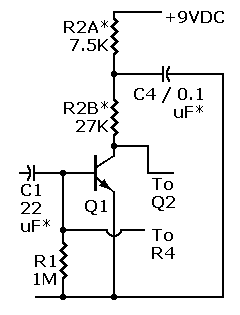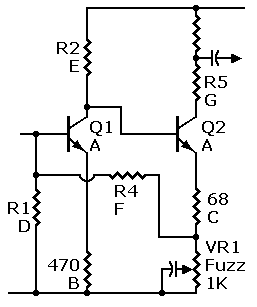Troubleshooting & Mods
| Symptom | Possible Problem | Action |
| No sound |
|
|
| Still no sound |
|
|
| Pots turn backward | Wiring error | On the backward pot, flip the outside two wires. |
| Scratchy sound when turning a pot | Bad pot | Replace bad pot. |
| Need more bass |

|
Note the starred parts in the diagram, left.
|
| Need more treble | Capacitors are too large. | Replace all capacitors with smaller values: For example, try C1 = 0.47 μF; C2 = 4.7 μF; C3 = 0.022 μF. |
| Too much fuzz |

|
|
| Not enough fuzz |
|
|
For softer fuzz, add a stabilizer
Softening is stabilizing. Players sometimes compare the "classic" 1960s fuzz to today's fuzz. They mention how the older effects sounded "softer" or "smoother." You can achieve a softer effect today. One way to do that is to introduce some stability into the circuit. By design, the fuzzbox is a temperamental beast. You can tame this beast without losing the passion. Stability the way. Troubleshooting mods B and C above are key.
Notes about mods B & C (above). The circuit affects gain as much as does the device type. An unbypassed emitter resistor introduces negative feedback. This feedback reduces gain, but it also stabilizes the circuit and sweetens the sound. Adding an emitter resistor can cause a silicon transistor to match a germanium device's gain. This fact certainly isn't true for every circuit. In a conventional amplifier, this change also requires changing the base bias network. Yet the Dallas Arbiter fuzz circuit is different. It so overdrives the transistors that small emitter resistors won't make much difference in the bias.
Rules. Here are the two rules for tweaking your emitter circuit...
- Need softer fuzz? Increase the emitter resistor value. Use the range that I suggest in the Troubleshooting and Mods Table above.
- Did the box stop working? Reduce your emitter resistor value. Or: Increase the resistor from base to ground.
Using Radio Shack transistors. Let's say that you're using two Radio Shack MPS2222A transistors (part number 276-2009 or a bargain-bag equivalent). Despite what the package says, these devices have a typical current gain of about 200. (Older versions of the same device have a much lower gain, down to about 50. I ignore these old versions.) Here are my starting suggestions...
- Assumption: You need a first-stage gain of 70. Add a 470-ohm emitter resistor, reducing the gain to (33K / 470), or 70.2.
- Assumption: You need a second-stage gain of 120. Add a 68-ohm emitter resistor, reducing the gain to (8500 / 68), or 125. Of course, the fuzz pot allows further fuzz reduction.
- Experiment! Beta (current gain) isn't a constant value. When current through the device varies, beta varies, too. Even with direct current, the beta is only constant for a particular device at a particular current. Because of the nature of beta, I can't state an exact resistor value to try. Instead, cut and try. That's what the hobby is about. Inventing can be fun.
Sensitivity. Adding emitter resistors also increases input impedance, the sensitivity of the transistors. A reflection of the emitter resistor times beta appears in parallel with the input resistors.
Intrinsic emitter resistance (REI). My suggestions ignore the intrinsic emitter resistance of the transistors. This resistance is a usually small value. It rises as device current falls. Regardless, the REI value further limits the gain of both germanium and silicon transistors. That is, an unbypassed emitter doesn't allow for infinite gain. Here are some average figures for the original fuzzbox. Remember that REI changes with the current through the transistor...
- For Q1, about 191 ohms.
- For Q2, about 41 ohms.
Resistor values. I assume that the resistor values are spot on. Otherwise, average intrinsic emitter resistance must differ from my figures.
Go to Page: 1 2 3 4 5 Next
- Advantages
- Depend on silicon
- Parts
- Equivalent parts
- Where to find parts
- Low-gain transistors
- Assembly tips
- Build the circuit board
- Build the case
- Test the effect
- Troubleshooting & Mods
- For softer fuzz, add a stabilizer
- Why you want silicon transistors
- Schematic: Fuzzbox
- Schematic: Switch wiring
- Schematic: More bass
- Schematic: Reduced, sweeter fuzz